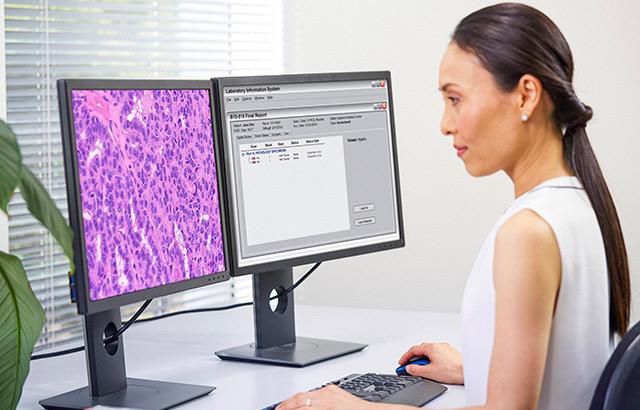
Digital Pathology in Developing Countries – Enabling Remote Operations during COVID-19 and Beyond

Pathology, particularly histopathology, is known to be a very busy and hectic field. Histopathologists are on alert to answer the queries of surgeons for frozen sections and, at other times, to convince or remove deadlocked opinions of surgeons. Residents in training stand at grossing stations or prepare cases to share with their case-qualified post-graduate pathologists, referred to globally as consultants. Cases do not just remain in the department; residents and consultants also have to present in multidisciplinary meetings to defend their diagnosis or findings to clinicians in case of discordance.
Without warning, COVID-19 slowly but robustly penetrated all nations globally, irrespective of their financial status, geography, and climate conditions. The entire world scenario changed beyond our imagination, and we had to go into lockdown. Other than the emergency departments of hospitals, all the non-emergency departments were partially closed. Histopathology departments also lost their pace and were restricted only to emergency surgical cases. Since COVID-19 predominantly has adverse effects on people over age 50 and those who have comorbidities, particularly those involving respiratory difficulty, a large proportion of the experienced pathology faculty remained at home or reduced their time in the lab to avoid unnecessary exposure.
No one knows how long the world will have to deal with a lockdown situation or whether there will be an emergence of a new wave of the pandemic, which would result in another lockdown. In these situations, histopathologists (particularly those working in developing countries) will have to change their strategy and prepare themselves to work predominately at home. In this era of uncertainty, digital pathology can act as a ray of hope, which facilitates pathologists working at home and, by a single click on their computer screens, perform their duties without risking their health and life.
Histopathology is considered the gold standard for most medical diagnoses.1 Histopathology is a subjective field that largely depends on a pathologist’s interpretation of the morphology of tissue. It has been almost two decades since the introduction of the whole slide imaging (WSI) scanner. During this time, various WSI devices have transformed the field of pathology.2 Digital pathology is a novel technology and is currently being implemented worldwide.3 Digital and computational pathology, partnered with artificial intelligence software and machine learning, set the stage for a groundbreaking shift in laboratory operations. Digital pathology enables the pathologist to perform most of their work at home. Numerous validation studies have been published indicating that WSI is a reliable tool for routine diagnosis in surgical pathology.4, 5, 6, 7 Unfortunately, due to the high cost of a pathology slide scanner, it remains cost-prohibitive in most of the labs in Third World countries. Though the pandemic will eventually end, its lasting effects will likely lead to permanent changes in how we live and work. We are becoming accustomed to remote technologies and the conveniences they offer. Although we will eventually go back to our regular workload, we will want to rely on these computer-based tools in many workplace environments as we settle into the reality of a post-COVID-19 world.
Digital pathology, which captures high-resolution images of tissue specimens, has been pivotal in enabling pathologists to maintain operations during the pandemic situation. These digital images can be viewed anywhere and easily shared for second opinions and consults, or in digital teaching sets, overcoming the limitations of working with physical glass slides and microscopes. The practice of sharing images at a distance is referred to as telepathology.
The COVID-19 crisis has offered pathologists, including those in Pakistan, no choice but to work from home, and this has broken down some of the regulatory barriers. It is evident that digital pathology and the new standard operating procedures will address pathologists’ urgent needs in the current crisis situation and afterward.
About the presenter

Dr. Talat Zehra is a consultant Histopathologist in Pakistan. Since 2016, Dr. Zehra also worked as a lecturer at Jinnah Sindh Medical University, Karachi. Her field of interest is digital pathology and its implementation in Pakistan.
References
1. Histopathology is ripe for automation. (2017). Nature biomedical engineering, 1(12), 925. https://doi.org/10.1038/s41551-017-0179-5.
2. Pantanowitz L, Sharma A, Carter AB, Kurc T, Sussman A, Saltz J. Twenty years of digital pathology: An overview of the road traveled, what is on the horizon, and the emergence of vendor-neutral archives. Journal of pathology informatics. 2018;9.
3. Molin J. Diagnostic Review with Digital Pathology: Design of Digitals Tools for Routine Diagnostic Use. Department of Computer Science and Engineering, Chalmers University of Technology; 2016.
4. Nielsen PS, Lindebjerg J, Rasmussen J, Starklint H, Waldstrøm M, Nielsen B, et al. Virtual microscopy: An evaluation of its validity and diagnostic performance in routine histologic diagnosis of skin tumors. Hum Pathol. 2010; 41:1770–6
5. Al-Janabi S, Huisman A, Vink A, Leguit RJ, Offerhaus GJ, ten Kate FJ, et al. Whole slide images for primary diagnostics of gastrointestinal tract pathology: A feasibility study. Hum Pathol. 2012; 43:702–7.
6. Al-Janabi S, Huisman A, Vink A, Leguit RJ, Offerhaus GJ, Ten Kate FJ, et al. Whole slide images for primary diagnostics in dermatopathology: A feasibility study. J Clin Pathol. 2012; 65:152–8.
7. Snead DR, Tsang YW, Meskiri A, Kimani PK, Crossman R, Rajpoot NM, et al. Validation of digital pathology imaging for primary histopathological diagnosis. Histopathology. 2016; 68:1063–72.
Related Content
Leica Biosystems Knowledge Pathway content is subject to the Leica Biosystems website terms of use, available at: Legal Notice. The content, including webinars, training presentations and related materials is intended to provide general information regarding particular subjects of interest to health care professionals and is not intended to be, and should not be construed as, medical, regulatory or legal advice. The views and opinions expressed in any third-party content reflect the personal views and opinions of the speaker(s)/author(s) and do not necessarily represent or reflect the views or opinions of Leica Biosystems, its employees or agents. Any links contained in the content which provides access to third party resources or content is provided for convenience only.
For the use of any product, the applicable product documentation, including information guides, inserts and operation manuals should be consulted.
Copyright © 2025 Leica Biosystems division of Leica Microsystems, Inc. and its Leica Biosystems affiliates. All rights reserved. LEICA and the Leica Logo are registered trademarks of Leica Microsystems IR GmbH.

